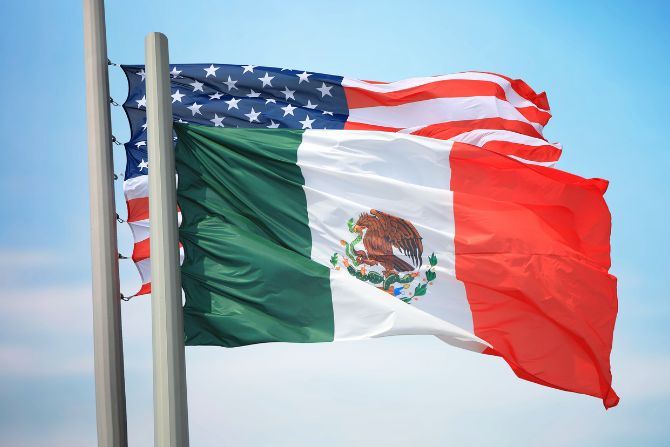
The Mexico-U.S. tariffs 2025 will cause significant disruption to international trade, with a 25% tariff on steel, aluminum, and auto exports beginning March 4, 2025. These new trade policies will have a significant impact on exporters, manufacturers, and supply chains across North America.
In this article, we explore how these tariffs will impact businesses and how ILS Company can help you efficiently navigate these challenges.
In addition, China will face gradual tariff increases of up to 60%, reshaping global supply chains. In this environment, companies must quickly adapt their strategies to minimize costs and remain competitive.
💡 How ILS Company Helps You
At the ILS Company, we understand the challenges these changes bring to businesses. Our logistics and international trade experts are ready to help you optimize imports and exports, ensure compliance with new regulations, and reduce unnecessary costs.
Table of Contents
- Key Dates and Tariff Changes: Mexico-U.S. 2025
- How Mexico-U.S. Tariffs 2025 Affect the Steel & Aluminum Industry
- Automotive Sector: 25% Tariff Starting April 2025
- The USMCA and the 2026 Review: Opportunity or Risk?
- Tariffs on China and Their Impact on Mexico
- Strategies to Overcome Mexico-U.S. Tariffs 2025 Challenges
- FAQs: Mexico-U.S. Trade Tariffs
- Conclusion
📅 Key Dates and Tariff Changes: Mexico-U.S. 2025
Starting March 4, 2025, the U.S. will implement the following import tariffs:
New U.S. Tariffs for 2025
| Product | Tariff 2024 | New Tariff 2025 |
|---|---|---|
| Steel & Aluminum | 0% – 10% | 25% |
| Automobiles & Auto Parts | 2.5% | 25% (Starting April 2025) |
| Energy (Oil, Gas, Critical Minerals) – Canada Only | 0% – 5% | 10% |
| Imports from China | 25% | 35% (February) → 45% (March) → 60% (End of 2025) |
Exemptions and Special Cases
✅ Donated goods (food, clothing, medicine) will be exempt from tariffs.
✅ Educational materials (books, brochures) will not face additional fees.
✅ Repaired goods or those in Foreign Trade Zones (FTZ) may qualify for special treatments.

Not all imports will be affected by the 2025 tariffs—donated goods such as food, clothing, and medicine remain exempt under U.S. trade policies.
💡 At ILS Company, we can help you properly classify your products to take advantage of these exemptions and avoid unnecessary costs.
🔍 How 2025 Mexico-U.S. Tariffs Will Affect the Steel & Aluminum Industry
The 25% tariff on steel and aluminum will severely impact Mexico’s ability to compete in the U.S. market.
📌 Consequences for the Steel & Aluminum Industry
| Impact | Consequence for Mexico |
|---|---|
| Higher export costs | Lower profit margins for manufacturers |
| Unfair competition with U.S. producers | U.S. companies gain an artificial advantage |
| Lower demand from the U.S. | Possible production cuts in Mexico |
| Companies seek alternative markets | Increased focus on Europe and Asia |
🚗 Automotive Sector: 25% Tariff Starting April 2025
The automotive sector, which represents 80% of Mexico’s exports to the U.S., will be hit hard by the 25% tariff.
📊 Key Data on Mexico’s Automotive Industry
- 2.7 million vehicles exported to the U.S. in 2024.
- General Motors, Ford, and Stellantis depend 80-90% on the U.S. market.
- $30 billion in additional costs if the tariff is applied.
- 500,000 jobs at risk if production is reduced.

Mexico’s automotive industry, which exports 80% of its production to the U.S., faces major challenges due to the 25% tariff imposed in April 2025.
🌎 The USMCA and the 2026 Review: Opportunity or Risk?
The USMCA (United States-Mexico-Canada Agreement) review in July 2026 will be a key moment for North American trade.
Potential Renegotiation Points
✅ Rules of origin for steel and automobiles.
✅ Incentives for local manufacturing.
✅ Elimination of tariff barriers in key sectors.
Tariffs on China and Their Impact on Mexico
In 2025, U.S. tariffs on Chinese goods will gradually increase to 60%, significantly changing the dynamics of global trade. While these tariffs are aimed at reducing U.S. dependence on China, they will also create new opportunities and risks for Mexico.
Key Changes in U.S. Tariffs on China (2025)
| Year | Tariff on Chinese Goods |
|---|---|
| 2024 | 25% (on selected goods) |
| Feb 2025 | 35% |
| March 2025 | 45% |
| End of 2025 | 60% |
📈 Increased Nearshoring to Mexico
With higher tariffs on Chinese goods, many U.S. companies will shift production to Mexico to take advantage of trade benefits under the USMCA (T-MEC). This trend, known as nearshoring, has already led to significant investment in Mexico’s manufacturing sector.
🚛 Supply Chain Disruptions & Higher Costs
Many Mexican manufacturers rely on Chinese raw materials and components. With higher tariffs on these imports, production costs in Mexico could rise, affecting industries like automotive, electronics, and machinery.
📉 Competitive Pricing Challenges
If Mexican exports to the U.S. become more expensive due to rising costs of Chinese materials, some U.S. companies may seek alternative suppliers in other regions like India, Vietnam, or South America.
📊 Market Shifts & Investment Growth
Despite the risks, Mexico could attract new foreign investment, particularly in industrial zones near the U.S. border, as companies seek duty-free supply chain alternatives.

The Mexico-U.S. tariffs 2025 will disrupt international trade, impacting steel, aluminum, and auto exports. Businesses must adapt to stay competitive.
Global Consequences
📌 U.S. companies will seek alternatives in Mexico, increasing investment.
📌 Higher pressure on global supply chains.
📌 Possible price increases for imported products from Asia.
💡 Just In Case: At the ILS Company, we offer nearshoring consulting services to help your businesses move operations to Mexico.
📢 Strategies to Overcome Mexico-U.S. Tariffs 2025 Challenges
🔹 Optimize logistics routes: Find efficient alternatives.
🔹 Leverage USMCA benefits: Ensure compliance with rules of origin to avoid tariffs.
🔹 Diversify markets: Explore new opportunities in Europe and Latin America.
🔹 Monitor regulatory changes with the ILS Company team.
FAQs: Mexico-U.S. Trade Tariffs
When do the new tariffs take effect?
- March 4, 2025 – 25% tariffs on steel and aluminum take effect.
- April 4, 2025 – 25% tariffs on automobile exports begin.
- February to December 2025 – China’s tariffs will increase progressively from 25% to 60%, affecting global supply chains.
How will the 2025 tariffs impact Mexican exporters?
The Mexico-U.S. 2025 tariffs will increase costs for manufacturers and exporters, making Mexican products less competitive in the U.S. market. The most affected industries include:
✅ Steel & Aluminum – Higher export costs and lower profit margins.
✅ Automotive – Potential $30 billion in additional costs and 500,000 jobs at risk.
✅ Manufacturing & Logistics – Supply chain disruptions and higher shipping costs.
How can businesses reduce or avoid these tariffs?
To minimize or avoid tariffs, businesses can:
✅ Leverage USMCA benefits – Ensure compliance with rules of origin to qualify for tariff exemptions.
✅ Diversify export markets – Expand operations to Europe, Latin America, and Asia.
✅ Reconfigure supply chains – Shift sourcing and production strategies.
✅ Work with logistics experts – at the ILS Company, we can help your business find cost-effective solutions.
What exemptions are available under the 2025 U.S. tariffs?
Some goods are exempt from tariffs, including:
✅ Donated goods (food, clothing, medicine).
✅ Educational materials (books, brochures).
✅ Goods undergoing repairs or processed in Foreign Trade Zones (FTZs).
Conclusion
The Mexico-U.S. trade battle is far from over. The new 25% tariffs in 2025 pose a significant challenge for exporters and manufacturers, particularly in the steel, aluminum, and automotive sectors.
🌍 Navigating these new tariffs doesn’t have to be a problem. At the ILS Company, we offer customized solutions to minimize costs and optimize your international trade operations.
💬 Worried about tariffs? Contact us today and secure your company’s future in global trade! 🚛📦


